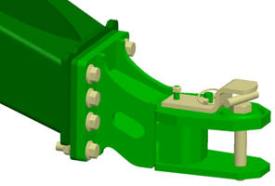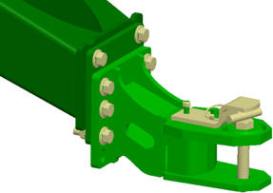
Key Features
- Two models: twine or netwrap
- Makes tight and dense 4’ x 5’ bales
- Adjustable hitch to match wide array of tractor drawbar heights
Features
Audible alarm
 BaleTrak Pro monitor-controller
BaleTrak Pro monitor-controller
The BaleTrak Pro monitor-controller is included with the automatic electric tie option and the Edge-to-Edge option on the 459E. The monitor sounds an alarm for near-full, full, and oversized bales.
- Monitor beeps once to notify the operator to even-up the bale prior to reaching the desired size.
Monitor beeps twice when the bale reaches the desired size.
If the operator continues to feed hay into the baler, the monitor will sound continuously to warn of an oversized bale.
- Bale shape bars are not available on the 449 or 459E Round Balers. The 449 and 459E Round Balers allow for adjustment of twine settings from the cab by using the BaleTrak Pro Monitor.
- The number of wraps on the Edge-to-Edge netwrap option on the 459E can be set with the BaleTrak Pro.
The audible level of the monitor can be adjusted.
 Side view of adjustable hitch
Side view of adjustable hitch Front view of adjustable hitch
Front view of adjustable hitchThe 9 Series Round Balers come standard with an adjustable hitch. This feature allows the hitch height to be adjusted to optimize crop-feeding performance. Due to the wide array of tractor tire sizes and drawbar heights, hitch adjustment may be necessary to get the proper feed opening of the baler. The adjustable hitch eliminates the need for the 51-mm (2-in.) thick tractor drawbar kit (AE57344) because it has a wider opening.
Benefits of the adjustable hitch:
- Ability to match baler to numerous tire sizes
- Allows for drawbar height to fall within 330 mm to 559 mm (13 in. to 22 in.) from top of drawbar to the ground
- Eliminates narrow feed opening on baler which can cause plugging
- Allows pickup head to follow terrain without missing crop
All eight bolts must be used when adjusting the hitch. There are four different positions as shown below:
 Position 1 (top) - Regular and MegaTooth™ pickups
Position 1 (top) - Regular and MegaTooth™ pickups Position 2
Position 2 Position 3 (factory setting) - MegaWide™ Plus pickups
Position 3 (factory setting) - MegaWide™ Plus pickups Position 4 (bottom)
Position 4 (bottom)Also standard on all 9 Series Round Balers except the 459E is the drawbar flap. This helps to eliminate hay from getting caught on the hitch of the baler. The drawbar flap is designed to allow the operator to remove or attach the flap without having to unhook the baler from the tractor.
 Drawbar flap
Drawbar flap Drawbar flap installed on baler
Drawbar flap installed on baler Regular pickup on 459E Baler with converging wheels
Regular pickup on 459E Baler with converging wheels
Mounted in front of the baler wheels and directly below the bale chamber, the pickup hugs the ground for clean crop retrieval. Hay movement is minimized.
- V-belt driven
- 449, 459E, and 459 Baler pickups are 116.6 cm (45.9 in.) wide
- 559 and 569 Baler pickups are 156 cm (61.4 in.) wide
- Large reel shaft and reel bearing
The small-diameter, low-profile pickup allows for good ground gauging and clean crop retrieval.
- Handles large, heavy windrows of hay and high-moisture crops
- Feeds hay directly to the forming chamber to reduce crop loss
- Low-profile pickup minimizes hay lift to reduce chaffing to retain hay quality
Side flares prevent hay from blowing off the pickup ends and reduce hay loss.
The closely spaced pickup teeth extend to the baler side sheets to help build straight-edged bales.
Standard on regular and MegaTooth™ pickups, compressor rods are contoured to control hay over the pickup radius for positive feeding. The compressor rack can be adjusted upward or downward to match the volume of material in windrow and can be easily removed to match crop conditions.
 Adjustable crank handle
Adjustable crank handle
The adjusting crank positions the pickup to the desired operating height to match crop or field conditions.
An optional hydraulic pickup lift cylinder is available as an attachment.
- Makes raising for transport or clearing obstructions easy
- Crank handle serves as a down stop
- Adapts to regular, MegaTooth and MegaWide™ Plus pickups
- Hydraulic pickup lift comes standard on premium machines
 Bale-starting diagram
Bale-starting diagram
As the hay enters the forming chamber from the pickup, belts turn the hay immediately to form a tight, dense core.
Incoming hay then feeds between the bale and the lower-gate roll. Hay is tightly compressed into smooth, dense layers as it enters the bale.
Chaffing is greatly reduced to prevent loss and retain hay quality in the bale.
 Full-sized bale in bale chamber
Full-sized bale in bale chamber
The idler arm rises with bale growth, forcing oil from the hydraulic cylinder through a pressure-relief valve:
- Maintains uniform bale density throughout the bale-forming process
 Staggered belts
Staggered belts
John Deere's 17.8-cm (7-in.) wide diamond-tread design ensures fast bale starts and grips the bale to prevent slippage and reduce chaffing. The treads are self-cleaning to reduce carryover.
The belts are staggered to reduce the loss of fine material and are closely spaced to contain the hay for fast, easy starts.
The belts enclose 91 percent of the bale width to reduce the loss of fine material and retain hay quality.
The staggered belt roll design enables any loose hay under or behind the belts to be returned to the pickup and into the baler.
This design helps to prevent buildup at the front of the baler, which could cause hay loss and belt or splice damage.
 Three-ply belts
Three-ply belts
The 449 and 459E Balers use three-ply belts. The belts are constructed of three-ply nylon-polyester combination:
- They have the strength to handle heavy-shock loads and help to maintain consistent belt length.
- Polyester is used for increased strength and reduced belt stretch.
Extra-service-life belt splices
 Extra-service-life splices
Extra-service-life splices
The 449 and 459E Balers use extra-service-life, rectangular, wire-belt splices:
- Flat surface reduces wear on the splice as the belt travels around the rolls.
- Strong hook shape increases the splice life as the belt flexes.
The material thickness and bend radius resist the opening of hook points and reduce metal fatigue.
 Larger shafts – 8 Series, 9 Series, 9 Series Premium
Larger shafts – 8 Series, 9 Series, 9 Series Premium
The 9 Series Round Balers have increased their durability by increasing the shafts and bearings on the top and bottom rolls of the baler. The size of the shafts and bearings are listed below:
- 8 Series - 31.8-mm (1.25-in.) shaft and 90-mm (3.5-in.) outside diameter (OD) bearing (this bearing requires a quill assembly to fit in the roll)
- 9 Series - 38.1-mm (1.5-in.) shaft and 130-mm (5.1-in.) OD bearing (this bearing does not require a quill assembly to fit in the roll)
- 9 Series Premium - 44.5-mm (1.75-in.) shaft and 130-mm (5.1-in.) OD bearing
The #9 and #11 rolls receive the most wear and stress since they have the most surface area contact with the belts. The lower gate roll also carries the weight of the bale. By increasing the shaft size, strength is added to the baler. The larger bearings will run cooler, therefore, increasing the life of the bearings.
 Diagram of rolls on baler
Diagram of rolls on balerBale
| Size | Diameter 89 to 152 cm 35 to 60 in. Width 117 cm 46 in. |
| Weight | Full-size bale in dry crop 454 kg 1,000 lb |
Baler
| Base weight | 1,701 kg 3,750 lb |
| Weight* | |
| Length | Gate closed 361 cm 142 in. Gate open 455 cm 179 in. |
| Height | Gate closed 260 cm 102 in. Gate open 325 cm 128 in. |
| Width | With standard tires 226 cm 89 in. |
Bale forming
| Forming chamber | Variable |
| Belts-other | Number 6 belts Strength 3-ply Width 17.8 cm 7 in. Length, regular Two: 1,171 cm 461 in. Length, staggered Four: 1,185 cm 467 in. Fabric Nylon polyester combination Texture Diamond tread |
| Enclosed % of bale surface | 91 percent |
| Belt splices | Extra service life |
| Density control | Hydraulic, isolated tractor |
| Bale size indication |
Regular pickup
| Width | Inside 117 cm 46 in. Flare 142 cm 56 in. |
| Drive | Roller chain with V-belt |
| Bars | 4 |
| Number of teeth | 72 |
| Tooth spacing | 6.6 cm 2.6 in. |
| Lift control | Crank |
| Gauge wheels | Optional |
| Stripper diameter | 25.4 cm 10 in. |
Mega wide pickup
| Width | |
| Drive | |
| Bars | |
| Number of regular teeth | |
| Number of mega teeth | |
| Tooth spacing | |
| Lift control | |
| Gauge wheels | |
| Stripper diameter |
Mega tooth pickup
| Width | |
| Drive | |
| Bars | |
| Number of middle teeth | |
| Number of mega teeth | |
| Tooth spacing | |
| Lift control | |
| Gauge wheels | |
| Stripper diameter |
Wrapping system
| Control | Automatic to preset to bale size |
| Type | Standard Electric |
| Twine arms | Two |
| Twine ball capacity | Four |
Monitor
| Monitor console for tractor | BaleTrak Pro |
| Gate closed | Symbol on monitor |
| Bale forming | |
| Bale size | Digital display |
| Near full bale | Audible |
| Full bale | Audible |
| Twine arm position Indicator | Mechanical indicator |
| Auto wrap | Activates when bale reaches preset size |
| Oversize bale | Audible and Mechanical |
Surface wrap
| Available | Edge-to-Edge optional |
Tire size
| Standard | 11L-14, 8-ply |
| Optional |
Driveline
| Drive protection | Shearbolt |
| PTO speed | 540 rpm |
| Type | Constant velocity, category 3 |
| PTO lockback collar on tractor hookup | Yes |
| PTO 60-degree free rotation |
Tractor Requirements
| Minimum PTO | 42 kW 55 hp |
| Hydraulic SCV valves |
Silage baler features
| Starter roll scraper | |
| Powered scraping auger | |
| Spirals on gate roll | |
| Pre-cutter/slicer |
Additional information
| Date collected | |
| Maintenance chains |

